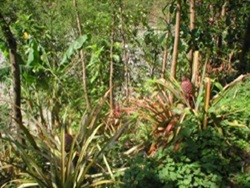 "My family will not have to die of hunger......."
"My family will not have to die of hunger......."
The prince turned into a pauper overnight when Man Bahadur Praja's 1.3 hectares of cultivable land in Makawanpur was washed away by landslide and flood in 2002. With his productive land gone, he was compelled to rely on his khoria land—
cultivation in a steep land.Usually, maize, black gram, mustard and horse gram are grown in the khoriya and the yield is really low, hardly sufficient to survive.
Makawanpur, a typical mid hill district occupies the land area of 242,600 ha with less than 7% cultivable land. Remaining 93% land are under serious threat and the researchers often blame deforestation, slash and burn practice, other unsustainable land use and flood and landslide as elements that threaten the livelihood of the local people.
With support from UNDP/ GEF Small Grants Programme, Manahari Development Institute-Nepal (MDI-Nepal) has since 2004 started Sloping Area Land Technique (SALT) in Makawanpur to improve the khoriya land by involving the local people, Chepangs and Tamangs (indigenous tribe).
Earlier, the agriculture period was shorter followed by a long forestry period(which is known as fallow period). Whatever vegetation grew during the fallow period was slashed and burnt that provided nutrients to the agriculture crop. As the need rose for more crops, people started cultivating in the gap of 3 to 4 months followed by a shorter fallow period with frequent slash and burn. As a result, this steep slope ranging from 30-60 degrees started suffering from soil erosion and landslide.
After terrace improvements and with active support from the community, the project decided to introduce agro-forestry by planting banana, pineapple and other fodder trees in the sloping land.
"Crop identification is a very challenging task while initiating the project", says Mr Khop Narayan Shrestha, co-ordinator of the project."It was really difficult to change the traditional agricultural practice of the local people as the risk factor is really high. If the selected crop failed, the farmers would not even get what they were getting from the khoriya land," adds Mr. Shrestha.
Until now, 429 ha. of khoriya land has been brought under the agro-forestry benefiting 938 households. Out of the 938 houses, 440 are Tamangs, 461 are Chepangs and 20 are dalits.
The farmers now have the experience of earning upto Rs. 3 million by planting over 600,000 saplings of banana, pineapple and fodder trees. The income ranges from Rs. 1,000 to 45,000 per household.
Thanks also to the generous support from Danish Embassy, Poverty Alleviation Fund (PAF), World Food Programme (WFP), Alternative Energy Promotion Centere (AEPC), German Technical Support (GTZ) and Rural Community Infrastructure Work (RCIW) who supported various activities of this project.
The preliminary impact study carried out by the project showed that the income is used by the community people to pay school fees of their children, buying stationery and paying debts. Likewise, 230 households have installed solar home system, 28 households have constructed biogas and more than 700 households have installed improved cooking stove.
The production of pineapple and banana has provided the households especially women and children, the nutritional supplementary diet. With deep satisfaction, Mr Man Bahadur Praja says , "My family will not have to die of hunger".




